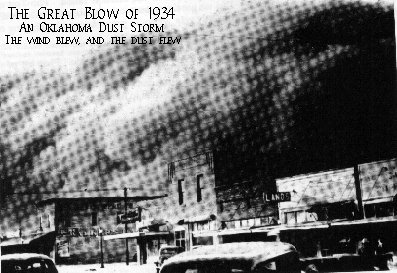|
Moderated by NW Okie! |
Volume 11 , Issue 262009Weekly eZine: (374 subscribers)Subscribe | Unsubscribe Using Desktop... |
Black Sunday Blizzard 1935

Online at History.com I did a search for a show that was on this Sunday, June 28, 2009, concerning the "Black Sunday Blizzard of '35" that blew millions of tons of topsoil through the high plains and heartlands.
April 14, 1935, the day of "The Black Sunday Blizzard" blew millions of tons of topsoil eastward towards the east coast. Soil Conservation techniques were soon to follow to perserve the "Dust Bowl" years of the 1930s. Oklahoma, Colorado, Texas, New Mexico and South Dakota feeling the "worst hard times" of that era.
According to HISTORY.COM's Major Dust Bowl Storm Strikes, It was one of the most devastating storms of the 1930s Dust Bowl era that swept through the heartland and the over-grazed, over-farmed plains bringing millions of tons of dirt and dust so dense, dark that some eyewitnesses believed the world was coming to an end.
By the early 1930s, the grassy plains of the plains of western Kansas, southeastern Colorado, panhandles of Texas and Oklahoma, and northeastern New Mexico had been over plowed by farmers and overgrazed by cattle and sheep. Soil erosion, combined with an 8-year drought that began in 1931, created a a dire situation for farmers and ranchers.
With the failure of crops and businesses failing and dust storms making people sick, many residents fled westward in search of work in other states such as California. Those who remained behind struggled to support themselves and their families.
By the mid-1930s, President Franklin D. Roosevelt?s administration introduced programs to help alleviate the farming crisis, such as the establishment of the "Soil Conservation Service (SCS) in the Department of Agriculture. The SCS promoted improved farming and land management techniques and farmers were paid to utilize these safer practices. For many Dust Bowl farmers, this federal aid was their only source of income at the time."
By 1939, a year before my folks, Gene McGill and Vada Paris, were married (March 1940), the Dust Bowl era came to an end when the welcome rains returned as the drought ended. We only hope that the improved farming techniques of that "Dust Bowl" has reduced the problem of soil erosion and prevented a repeat of the 1930's Dust Bowl devastation. -- Maps of the Dust Bowl 1935-40.
| View or Add Comments (1 Comments)
| Receive
updates ( subscribers) |
Unsubscribe
| © . Linda Mcgill Wagner - began © 1999 Contact Me | |
